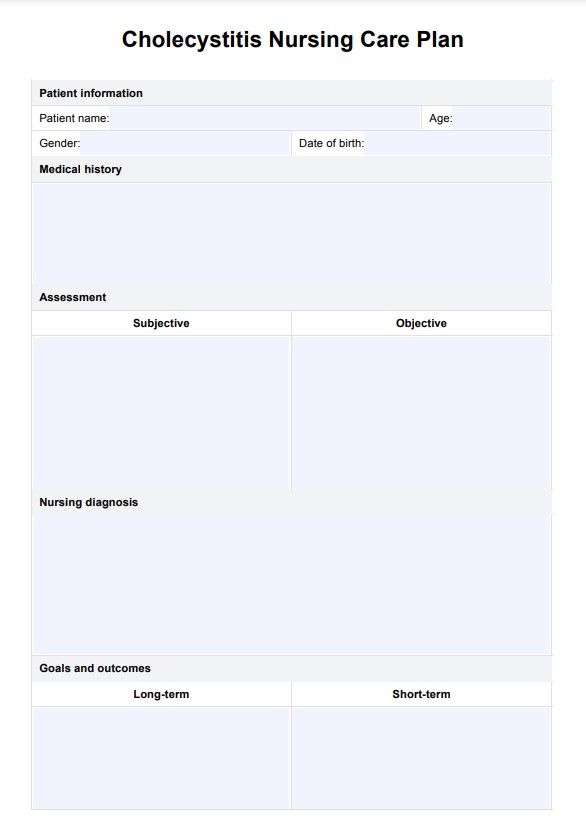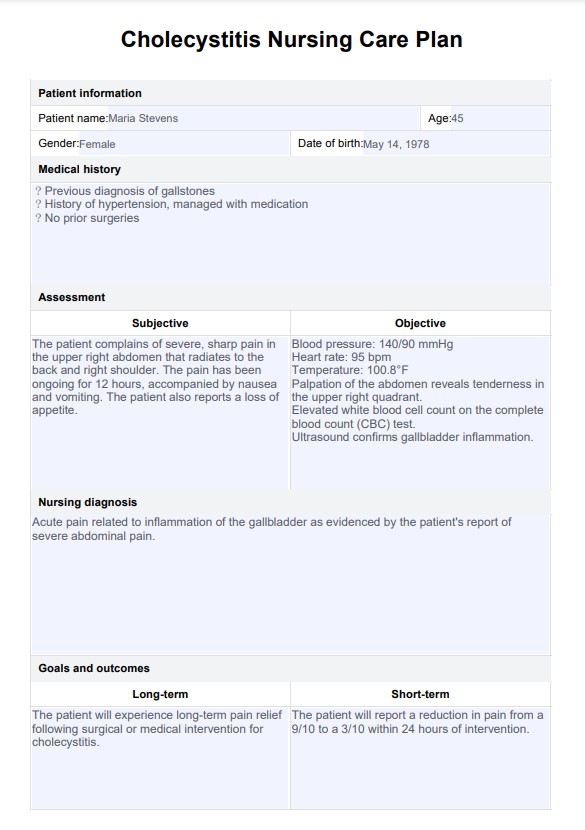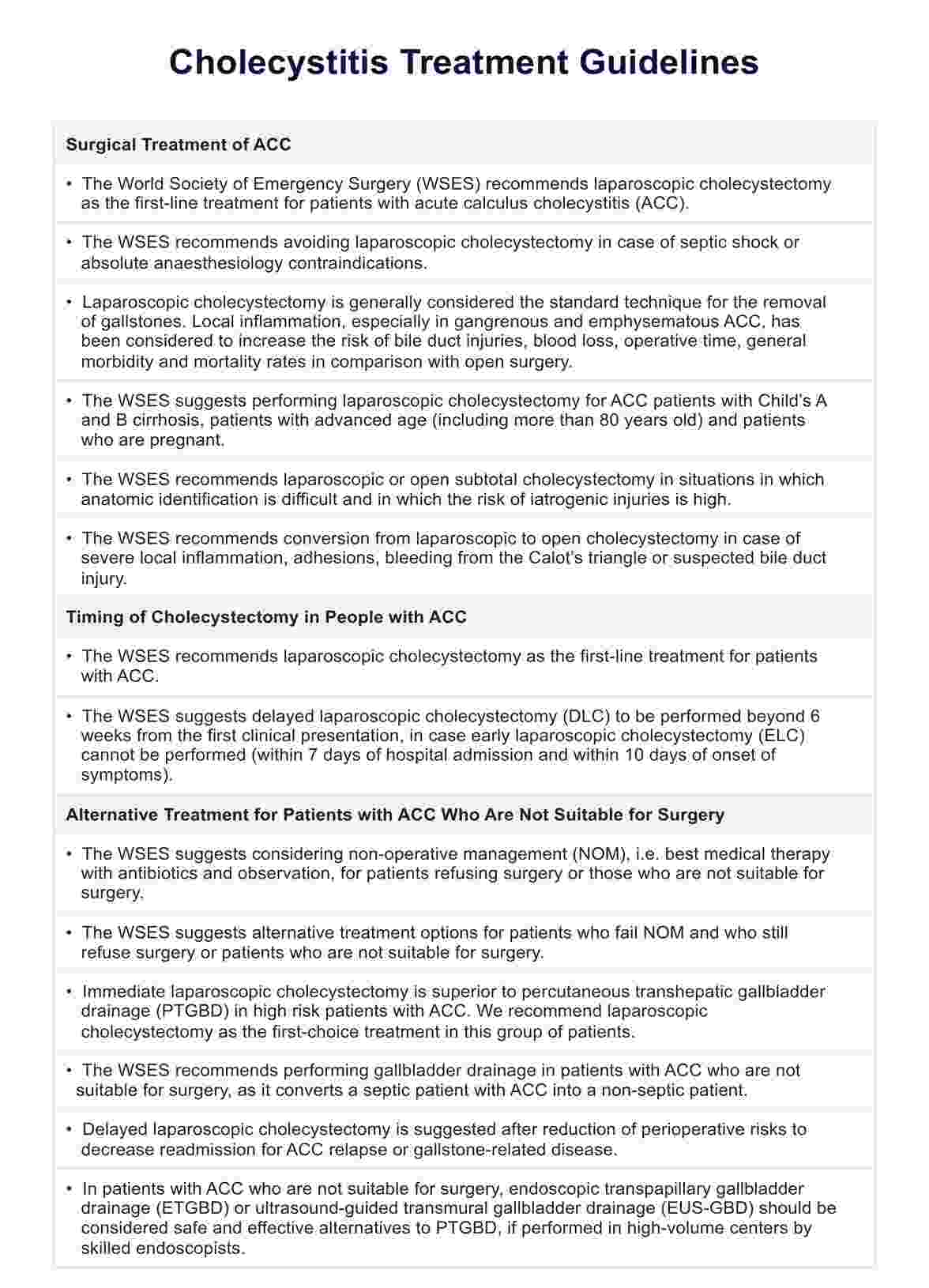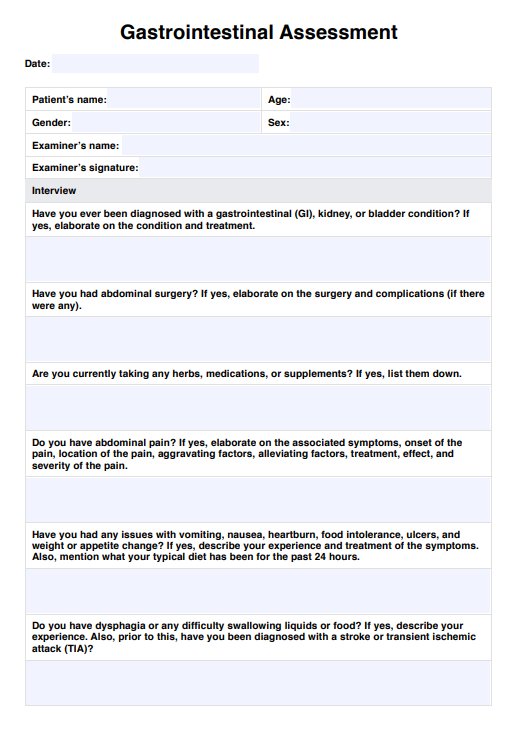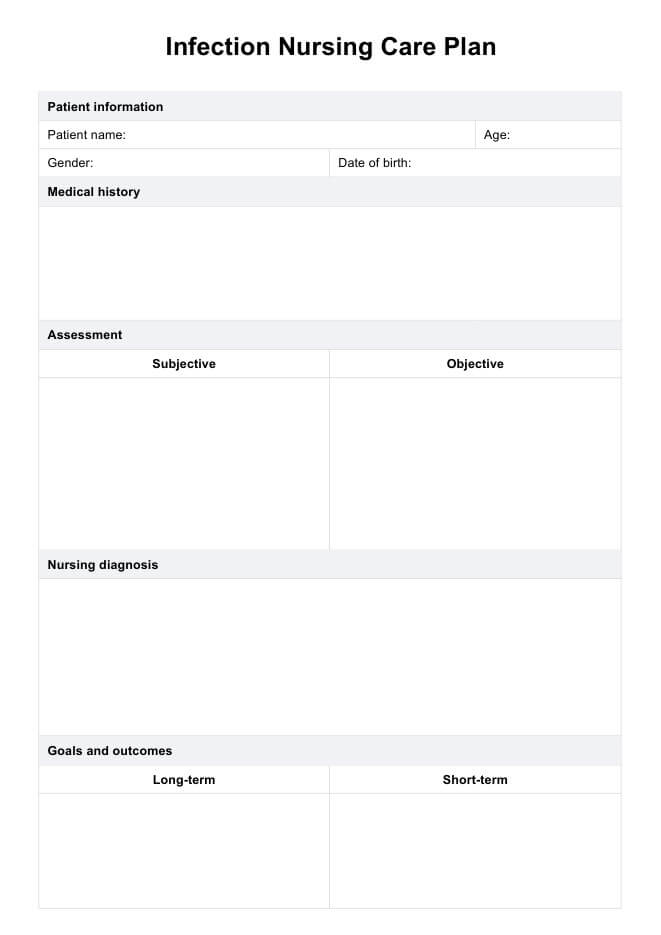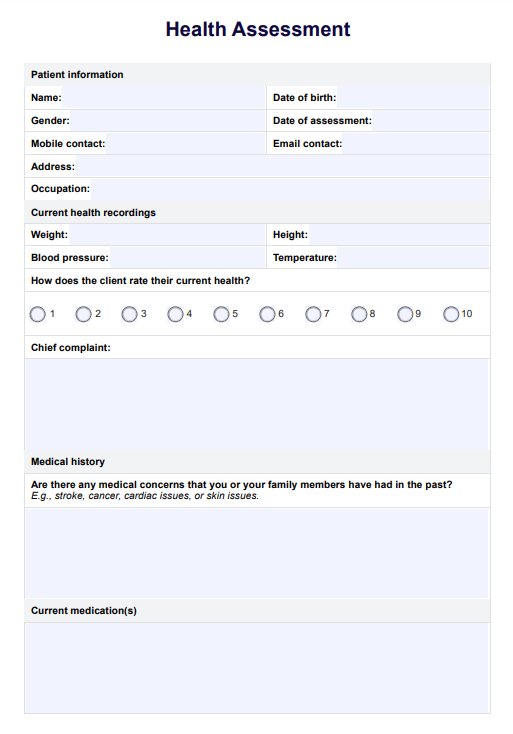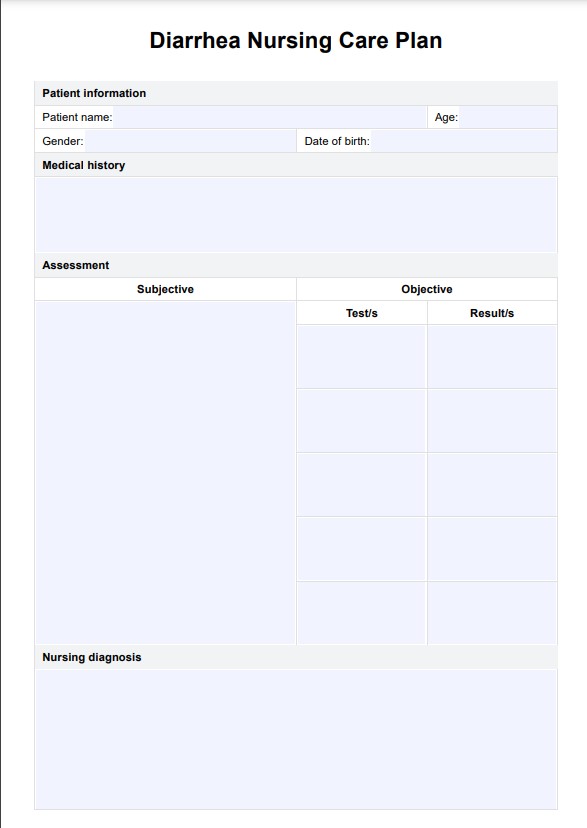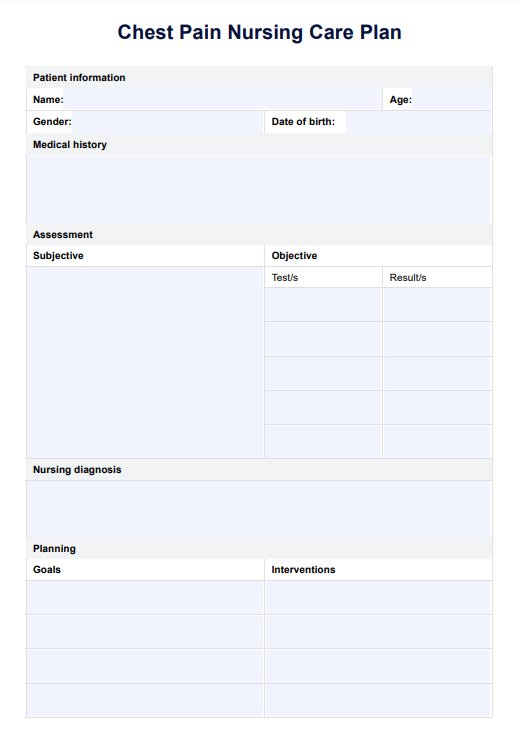Cholecystitis Nursing Care Plan
Discover our Cholecystitis Nursing Care Plan template to enhance patient care. Personalize interventions, monitor progress, and support recovery efficiently.


What is cholecystitis?
Cholecystitis is an inflammation of the gallbladder, a small organ located beneath the liver that stores bile. This condition can occur suddenly, known as acute cholecystitis, or develop gradually over time, referred to as chronic cholecystitis. Acute cholecystitis typically presents with intense pain in the upper right abdomen, which may radiate to the shoulder or back. This severe abdominal pain is a primary symptom of cholecystitis. Other symptoms can include nausea, vomiting, fever, and loss of appetite, indicating a need for immediate medical attention to prevent complications such as gallbladder rupture or infection.
Chronic cholecystitis, on the other hand, involves repeated episodes of inflammation, often due to gallstones obstructing the bile ducts. Gallstones can obstruct both the cystic duct and the common bile duct, leading to severe complications. This form of cholecystitis may cause milder, more intermittent pain but still requires careful management to avoid long-term damage. Both forms of cholecystitis necessitate a tailored nursing care plan to manage pain, monitor for complications, and educate patients on dietary adjustments and lifestyle changes to support recovery and prevent recurrence.
Cholecystitis Nursing Care Plan Template
Cholecystitis Nursing Care Plan Example
What is a Cholecystitis Nursing Care Plan?
A Cholecystitis Nursing Care Plan is a strategic framework developed by nurses to deliver comprehensive and holistic care to patients diagnosed with cholecystitis, an inflammation of the gallbladder typically caused by gallstones that obstruct bile flow.
This nursing care plan employs a systematic approach to assess the patient's needs, formulate appropriate interventions, and evaluate their effectiveness in managing symptoms and complications associated with this condition. The primary goal is to promote optimal health and well-being while preventing potential complications.
The Cholecystitis Nursing Care Plan focuses on providing individualized care that considers unique patient factors such as age, gender, medical history, and lifestyle. It also emphasizes collaboration with other healthcare professionals, including physicians, nutritionists, and pharmacists, to ensure a well-rounded approach to managing cholecystitis.
Carepatron has created a straightforward Cholecystitis Nursing Care Plan template to assist nurses in easily crafting personalized care plans for their patients. This template features sections for assessment, nursing diagnosis, goals and outcomes, interventions, rationale, and evaluation, streamlining the care planning process.
How does our Cholecystitis Nursing Care Plan template work?
Here's how to use our printable Cholecystitis Nursing Care Plan template in simple steps:
Step 1: Download the resource
Click "Use Template" to access the care plan via the Carepatron app. You can also click "Download" to get a PDF copy.
Step 2: Assess your patient
Conduct a thorough assessment of your patient, including their medical history, current symptoms, and vital signs. Use the data to complete the various sections of the template accurately.
Step 3: Identify nursing diagnoses
Based on your assessment, identify the patient's specific problems and formulate relevant nursing diagnoses. This step helps you create goals and interventions tailored to their unique needs.
Step 4: Set goals and desired outcomes
With input from the patient and other healthcare professionals, set realistic goals and outcomes for managing their cholecystitis symptoms and preventing complications.
Step 5: Implement appropriate interventions
Select evidence-based interventions that align with the identified nursing diagnoses and goals. These may include administering medications, providing education on dietary changes, or collaborating with other specialists for further treatment.
Step 6: Document rationale and evaluation
Explain why each intervention is necessary and how it contributes to achieving the desired outcomes. Also, document your patient's response to each intervention and make adjustments as needed.
Step 7: Continuously evaluate progress
Regularly reassess your patient, monitor their progress towards the set goals, and modify the care plan accordingly. This step allows for ongoing optimization of care and ensures the best possible outcome for the patient.
Nursing interventions for cholecystitis
Part of an effective nursing care plan for cholecystitis involves implementing interventions to manage the patient's symptoms and prevent complications. Some potential nursing interventions for cholecystitis may include:
- Pain management: Effective pain management is crucial for patients experiencing severe pain or acute pain due to cholecystitis. Nursing interventions may include administering medications like analgesics as prescribed to relieve pain and monitor the patient’s response.
- Addressing abdominal distension: Nurses can assess the patient's abdominal girth and bowel sounds to alleviate abdominal distension. Interventions might include encouraging the patient to ambulate and utilizing positioning techniques to promote comfort and relieve pressure.
- Managing nausea and vomiting: Nausea and vomiting are common manifestations associated with cholecystitis. Nursing interventions may involve administering antiemetic medications to control these symptoms, ensuring that the patient remains hydrated and comfortable during episodes.
- Facilitating bile flow: Bile flow, possibly evidenced by symptoms such as jaundice and dark urine, can be a concern in cholecystitis patients. Nurses may facilitate bile flow by encouraging oral fluid intake, administering chenodeoxycholic acid (CDCA) or ursodeoxycholic acid (UDCA) medications, and monitoring for signs of obstruction.
- Providing education: Nurses can educate the patient on their condition, including risk factors, management strategies, and when to seek further medical attention if symptoms worsen. Education should also include post-operative instructions if surgery is required.
What are the benefits of having a nursing care plan?
A nursing care plan offers several advantages for managing cholecystitis, enhancing patient care, and promoting recovery. Here are five key benefits:
Personalized care for each patient
The plan is tailored to each patient’s unique needs, considering their medical history, including any history of gallbladder disease, signs and symptoms, pain levels, and overall health. This personalized approach ensures that interventions are specifically designed to address the individual patient’s condition, optimizing their recovery process.
Clear guidance and direction
A well-structured care plan provides a clear roadmap for recovery, outlining both short-term and long-term goals, such as managing pain and preventing recurrence. This clarity helps patients understand their treatment steps and directs their recovery journey.
Enhanced communication and teamwork
The care plan is a communication tool among healthcare providers, including nurses, doctors, and specialists, ensuring everyone is aligned to support the patient's recovery. This collaborative approach fosters a cohesive treatment strategy, improving overall patient care.
Proactive monitoring and prevention
Monitoring the patient's condition regularly and implementing preventive measures are integral to the care plan. This proactive stance helps detect potential complications early and reduces the risk of recurrent issues, promoting better patient outcomes.
Empowerment through education
The plan provides patients with crucial information about their condition, treatment options, and self-care strategies, empowering them to participate actively in their recovery. This education helps reduce anxiety and enables patients to make informed decisions about their health, leading to a more positive healing experience.
Commonly asked questions
The nursing plan for cholecystitis includes assessment, diagnosis, goals and outcomes, interventions, rationale and evaluation. These components work together to ensure that patients receive comprehensive and individualized care.
The nursing care plan for cholecystitis comprises several key components: assessment, diagnosis, goals and outcomes, interventions, rationales, and evaluation. Together, these elements ensure that patients receive thorough and personalized care tailored to their specific needs.
The nursing plan for cholecystectomy, the surgical removal of the gallbladder, is similar to that of cholecystitis. However, there are some specific considerations that must be taken into account for post-operative care.


